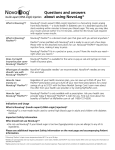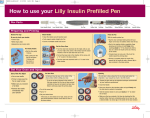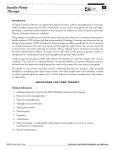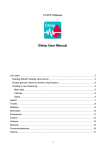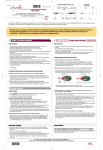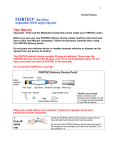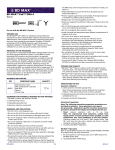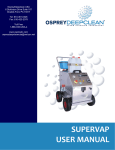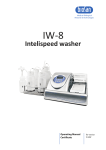Download KwikPen™
Transcript
1 PV 5590 AMP KwikPen™ Disposable Insulin Delivery Device User Manual Lilly (red script) Introduction The KwikPen™ is designed for ease of use. It is a disposable insulin delivery device (“insulin Pen”) containing 3 mL (300 units) of U-100 insulin. You can inject from 1 to 60 units of insulin in one injection. You can dial your dose one unit at a time. If you dial too many units, you can dial backwards to correct the dose without wasting any insulin. Before using the KwikPen, read the entire manual completely and follow the directions carefully. If you do not follow these directions completely, you may get too much or too little insulin. DO NOT USE your KwikPen if any part appears broken or damaged. Contact Lilly at 1-800-Lilly-Rx (1-800-545-5979) or your healthcare professional for a replacement Pen. Always carry an extra Pen in case yours is lost or damaged. This Pen is not recommended for use by the blind or visually impaired persons without the assistance of a person trained in the proper use of the product. Preparing the KwikPen Important Notes • Read and follow the directions provided in the Patient Information Leaflet. • Check the label on your Pen before each injection for the expiration date and to make sure you are using the correct type of insulin. • Your healthcare professional has prescribed the best type of insulin for you. Any changes in insulin therapy should be made only under medical supervision. • The KwikPen is recommended for use with Becton, Dickinson and Company pen needles. • Be sure the needle is completely attached to the Pen before use. • Do not share your Pen or needles. • Keep these directions for future reference. 2 Frequently Asked Questions about Preparing the KwikPen • What should my insulin look like? Some insulins are cloudy while others are clear. Be sure to refer to your Patient Information Leaflet for the appearance of your specific insulin. • Why should I use a new needle for each injection? This will help ensure sterility. If needles are reused, you may get the wrong amount of insulin, a clogged needle or a jammed Pen. • What should I do if I am not sure how much insulin remains in my cartridge? Hold the Pen with the needle end pointing down. The scale on the clear Cartridge Holder shows an estimate of the number of units remaining. These numbers should NOT be used for measuring an insulin dose. Priming the KwikPen Important Notes • Prime every time. The Pen must be primed to a stream of insulin before each injection to make sure the Pen is ready to dose. • If you do not prime, you may get too much or too little insulin. Frequently Asked Questions about Priming • Why should I prime my KwikPen before each dose? 1. Ensures that the Pen is ready to dose. 2. Confirms that a stream of insulin comes out of the tip of the needle when you push the Dose Knob in. 3. Removes air that may collect in the needle or insulin cartridge during normal use. • What should I do if I cannot completely push in the Dose Knob when priming the KwikPen? 1. Attach a new needle. 2. Prime the Pen. • What should I do if I see an air bubble in the cartridge? You need to prime the Pen. Remember, do not store the Pen with the needle attached as this may cause air bubbles to collect in the insulin cartridge. A small air bubble will not affect your dose and you can continue to take your dose as usual. 3 Injecting Your Dose Important Notes • Follow the instructions for sanitary injection technique recommended by your healthcare professional. • Make sure you receive your complete dose by pushing and holding the dose knob in and count to 5 slowly before removing the needle. If insulin is leaking from the Pen you may not have held it in your skin long enough. • The Pen will not allow you to dial more than the number of units left in the Pen. • If your dose is greater than the number of units left in the Pen, you may either inject the amount remaining in your current Pen and then use a new Pen to complete your dose OR inject the full dose with a new Pen. • Do not attempt to inject your insulin by turning the Dose Knob. You will NOT receive your insulin by turning the Dose Knob. You must PUSH the Dose Knob straight in for the dose to be delivered. • Do not attempt to change the dose while injecting. • The directions regarding needle handling are not intended to replace local, healthcare professional or institutional policies. • Remove the needle after completing each injection. Frequently Asked Questions about Injecting Your Dose • Why is it difficult to push the Dose Knob when I try to inject? 1. Your needle may be clogged. Try attaching a new needle. When you do this you may see insulin come out of the needle. Then prime the Pen. 2. Pressing the Dose Knob quickly may make the Dose Knob harder to push. Pressing the Dose Knob more slowly may make it easier. 3. Using a larger diameter needle will make it easier to push the Dose Knob during your injection. See your healthcare professional to determine which needle size is best for you. 4. If the Dose Knob continues to be difficult to push after following the steps above, try the steps below under “What should I do if my KwikPen is jammed?”. • What should I do if my KwikPen is jammed? Your Pen may be jammed if it is difficult to inject a dose or dial a dose. To clear the jam: 1. Attach a new needle. When you do this you may see insulin come out of the needle. 2. Prime the Pen. 3. Dial your dose and inject. 4. If the Dose Knob is still difficult to push, contact Lilly at 1-800-Lilly-Rx (1-800-545-5979). 4 • Why is insulin leaking from the needle after I finished injecting my dose? You may have removed the needle from your skin too quickly. 1. Make sure you see a 0 in the Dose Window to confirm you received the complete dose. 2. For the next dose, push and hold the Dose Knob in and count to 5 slowly before removing the needle. • What should I do if my dose is dialed and the Dose Knob is accidentally pushed in without a needle attached? 1. Dial back to zero. 2. Attach a new needle. When you do this you may see insulin come out of the needle. 3. Prime the Pen. 4. Dial your dose and inject. • What should I do if I dial a wrong dose (too high or too low)? Turn the Dose Knob backward or forward to correct the dose before injecting. • What should I do if I see insulin leaking from the KwikPen needle while dialing the dose or correcting the dose? Do not inject the dose because you may not get your complete dose. Dial the Pen down to zero and prime the Pen again (see “Priming the KwikPen” steps 2 B-D). Dial your dose and inject. • What should I do if my full dose cannot be dialed? The Pen will not allow you to dial a dose greater than the number of insulin units remaining in the cartridge. For example, if you need 31 units and only 25 units remain in the cartridge you will not be able to dial past 25. Do not attempt to dial past this point. You may either: 1. Inject the partial dose and then inject the remaining dose using a new Pen. or 2. Inject the full dose with a new Pen. • Why can I not dial the dose to use the small amount of insulin that remains in my cartridge? The Pen is designed to deliver at least 300 units of insulin. The Pen design prevents the cartridge from being completely emptied because the small amount of insulin that remains in the cartridge cannot be delivered. Storage and Disposal Important Notes • Refer to the Patient Information Leaflet for complete insulin storage instructions. • Pens that have not been used should be stored in a refrigerator but not in a freezer. Do not use a Pen if it has been frozen. 5 • • • • • Do not store the Pen with the needle attached. If the needle remains attached, insulin may leak from the Pen, insulin may dry inside the needle causing the needle to clog, or air bubbles may form inside the cartridge. The Pen you are currently using should be kept at room temperature and away from heat and light. Keep the Pen out of the reach of children. Dispose of used needles in a puncture-resistant container or as directed by your healthcare professional. Dispose of used Pens as instructed by your healthcare professional and without the needle attached. Use the space below to keep track of how long you should use each Pen in the carton. Once you start using a KwikPen it must be thrown out after the number of days listed in your Patient Information Leaflet, even if there is insulin remaining in the Pen. Record the date you start using a Pen, find the number of days that the KwikPen should be used in the Patient Information Leaflet and determine the date the Pen should be thrown out. Record the dates in the space provided below. Example: Pen 1 - First used on _______ + Number of days you should = Throw out on ______ Date use KwikPen (from Patient Date Information Leaflet) Pen 1 - First used on _______ Date Pen 2 - First used on _______ Date Pen 3 - First used on _______ Date Pen 4 - First used on _______ Date Pen 5 - First used on _______ Date Throw out on _______ Date Throw out on _______ Date Throw out on _______ Date Throw out on _______ Date Throw out on _______ Date If you have any questions or problems with your KwikPen, contact Lilly at 1-800-Lilly-Rx (1-800-545-5979) or your healthcare professional for assistance. For more information on KwikPen and insulin, please visit our website at www.humalog.com 6 Manufactured by: Eli Lilly and Company Indianapolis, IN 46285, USA Patents pending for KwikPen™. Copyright © 2007, Eli Lilly and Company. All rights reserved. The KwikPen meets the current dose accuracy and functional requirements of ISO 11608-1:2000. 7 Getting Ready Make sure you have the following items: Pen Parts KwikPen New Pen Needle Alcohol Swab KwikPen, and Needle∗ Assembly ∗sold separately Pen Needle Parts (Needles Not Included) KwikPen Parts Follow these instructions for each injection 1. Preparing the KwikPen A. B. C. D. Remove Paper Tab from Outer Needle Shield. Push capped needle straight onto the Pen. For Cloudy Insulin only: Pull Pen Cap to remove. Be sure to check your insulin for: • Type • Expiration date • Appearance Use an alcohol swab to wipe the Rubber Seal on the end of the Cartridge Holder. Gently roll the Pen ten times and invert the Pen ten times. The insulin should look evenly mixed. Note: Some insulins are meant to be cloudy (e.g., the insulin mixtures) while others are meant to be clear. Be sure to refer to the Patient Information Leaflet for the appearance of your specific insulin. Screw needle on until secure. 8 2. Priming the KwikPen Caution: If you do not prime before each injection, you may get too much or too little insulin. A. B. C. D. With needle pointing up, push Dose Knob in until it stops and 0 is seen in the Dose Window. Pull off Outer Needle Shield. Do not throw away. Pull off Inner Needle Shield and throw away. Dial 2 Units by turning the Dose Knob. Point Pen up. Tap Cartridge Holder to collect air at top. Hold Dose Knob in and count to 5 slowly. Priming is complete when a stream of insulin appears from the needle tip and you have counted to 5 slowly. If a stream of insulin does not appear, repeat priming steps 2 B-D up to four times. If the Pen still does not prime, change the needle and repeat the priming steps above. Note: If you do not see a stream of insulin from the tip of the needle and the Dose Knob becomes hard to push, then change the needle and prime the Pen. 9 3. Injecting Your Dose A. B. Turn Dose Knob to the number of units you need to inject. If you dial too many units, you can correct the dose by dialing backwards. Insert needle into skin using injection technique recommended by your healthcare professional. Example: 10 units shown. Place your thumb on the Dose Knob and push firmly until the Dose Knob stops. To deliver the full dose, hold Dose Knob in and count to 5 slowly. Remove needle from skin. Note: Check to make sure you see 0 in the Dose Window to confirm you received the complete dose. C. D. Carefully replace the Outer Needle Shield. Unscrew the capped needle and dispose of as directed by your healthcare professional. Note: Remove the needle after each injection to keep air out of the cartridge. Do not store the Pen with the needle attached. Replace Pen Cap. Example: 15 units shown. Note: The Pen will not allow you to dial more than the number of units left in the Pen. The even numbers are printed on the dial. The odd numbers, after the number one, are shown as full lines. Literature issued September 6, 2007 PV 5590 AMP









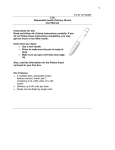
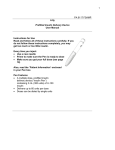
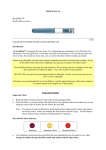

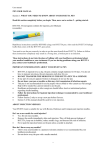
![TEMPLATE No1 [CPMP positive opinion full application]](http://vs1.manualzilla.com/store/data/005681628_1-1a3acb54fcca990dd8c826546eb4788f-150x150.png)
